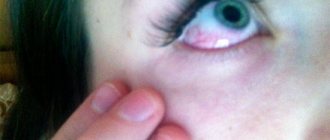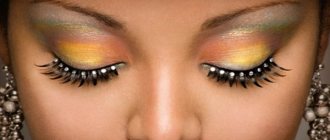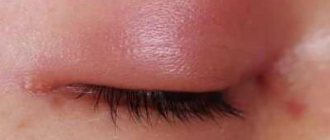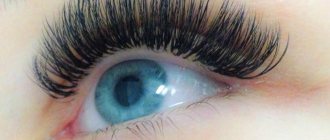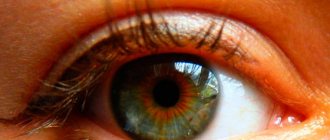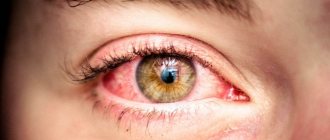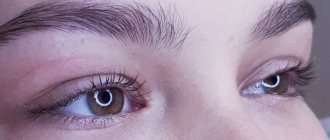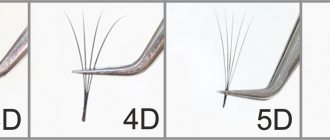Sometimes after the extension procedure, artificial eyelashes cause a feeling of discomfort - they prick, interfere, irritate the eyes, and there is an unpleasant sensation when touching the eyelid.
In such cases, most likely, the eyelashes will have to be removed - this is the only right decision. To prevent this from happening next time, remember 3 reasons for such a reaction:
- Poor quality materials used for extensions. The low price of the procedure is a reason to think about what materials the master works with;
- Increased eye sensitivity . This may be due to natural hypersensitivity, eye diseases, lack of sleep and even pregnancy. To prevent an unpleasant effect, it is recommended to do an allergy test the day before extensions;
- Violation of extension technology . If the master did not make an indent (the indent should be from 0.3 to 1 mm), left gluing or detachment of the base (when the base of the artificial eyelash does not fit with the natural one), then it is not surprising that the eyelashes get in the way.
How to understand what is causing the discomfort - an allergic reaction or the technician’s mistakes
Allergic reaction to glue
People with particularly sensitive eyes may become allergic to the components of the adhesive. The fact is that it does not polymerize immediately, but within about three days. All this time, the glue, evaporating, affects the mucous membrane of overly sensitive eyes.
In addition, a drop of glue may get into the eye if the technician is not very experienced or the client opens his eyes during the procedure, which is absolutely not allowed. The glue can also get into a microcrack in the eye area, resulting in a chemical burn.
Causes of eye redness after eyelash extensions
It is, of course, impossible to foresee everything. However, it is quite possible to protect yourself. To do this, you need to know the reasons why complications may arise after eyelash extensions.
Allergic reaction
The components that make up most adhesives are not hypoallergenic. These chemical components, especially resins and bimatoprost - a synthetic analogue of prostaglandin, which is used in ophthalmology to treat certain diseases and enhance eyelash growth - can cause allergic inflammation.
Signs of an allergic reaction: dry mucous membranes, swelling, itching, sneezing, runny nose, red eyes after eyelash extensions.
What to do? Make sure to do allergy tests about a day before the procedure. The technician will apply a small amount of glue to the skin and evaluate the condition of the skin after some time. In addition, you should warn that you are prone to allergies and tell them what may cause them.
Individual characteristics
If you wear contact lenses or are prone to inflammatory eye diseases - blepharitis, conjunctivitis, etc., the likelihood of experiencing the unpleasant consequences of eyelash extensions increases.
Signs of individual intolerance: the appearance of familiar symptoms of eyelid irritation, the rapid development of diseases to which there is a tendency.
What to do? Refuse eyelash extensions at the slightest suspicion of the onset of a pathological process.
Unprofessionalism and carelessness of the master
Close contact with such a sensitive organ requires maximum care and competence. Unfortunately, not all masters have these qualities. It happens that the master:
- violates the rules for sterilizing instruments or repeatedly uses disposable materials;
- works inaccurately: violates technology, incorrectly attaches artificial hairs, uses too much glue or allows it to come into contact with mucous membranes;
- allows you to open your eyes immediately after finishing the procedure - without first drying your eyelashes under a fan.
Signs:
severe hyperemia, irritation, pain, purulent or mucous discharge, lacrimation.
What to do?
Make sure the lash maker is professional before signing up for the procedure.
Failure to comply with the ban on extensions due to ophthalmic diseases
In this case, the fault lies with the client himself: for your part, you must also take eyelash extensions seriously. Styes, demodicosis, dermatitis or psoriasis on the eyelids and many other ophthalmological problems are contraindications for the procedure.
Signs:
deterioration of condition, relapse after extension.
What to do?
Postpone the procedure if you are being treated for conjunctivitis or any other eye disease.
Chemical burn
Contact of glue or its fumes on the mucous membrane will cause a chemical burn.
Signs of a chemical burn:
severe hyperemia and spots on the sclera, burning, lacrimation and pain, sensation of sand, foreign body.
What to do?
Contact your doctor immediately. Treatment of red eyes after eyelash extensions, depending on the degree of damage, can take place in a hospital or even on an outpatient basis.
Poor quality materials
For extensions, eyelashes are used both from natural materials (for example, silk or mink fur) and from artificial polymer fibers. According to reviews from girls on women's forums, natural eyelashes are a little softer and thinner, they do not cause any reaction. At the same time, the eyes may react negatively to polymer materials. You also need to consider what kind of glue the master will use, transparent or black. Transparent, unlike black, is hypoallergenic and does not contain harmful chemical components.
If your eyelashes cannot be combed from the roots with a brush
If the eyelashes cannot be combed with a brush from the first day after extensions, it means they have stuck together and there are glues between the eyelashes. Gluing is two or more eyelashes glued together, and artificial eyelashes are glued together with the natural ones. This causes significant harm to health due to the impact on the natural eyelash growth cycle.
Eyelashes glued together and red, irritated eyelid skin
Many girls don’t think about the fact that our eyelashes are constantly growing and renewing themselves. Each eyelash has its own life cycle: active growth - 2-3 weeks, resting 4-7 weeks, the rest is the rejection stage. So, if the eyelashes are connected to each other for a week, or even more, then this will prevent them from fully growing and falling out. As a result, you will get “tangles” on your eyelids or what is shown in the photo above.
Therefore, high-quality eyelash extensions are a state of eyelashes when each artificial eyelash is autonomous (extended separately). If she wants to fall out, she falls out and does not pull other hairs with her. Eyelash extensions can and should be combed with a brush in the morning after washing.
Violation of post-procedure care conditions
During the week after eyelash extensions, you need to adhere to certain rules: you cannot wet your eyes, take a shower, use eye creams or decorative cosmetics in general. The glue should completely harden within a few days. If water or cream gets in, it will simply “float” and the eyelashes will fall off, and the glue can get into the eyes and cause irritation.
If your eyelashes look terrible
If your eyelashes look like this or similar. The photos attached below are examples of illiterate eyelash extensions. Unfortunately, when you take off “those eyelashes,” you may not find your family underneath them. Since an excessive amount of glue does not allow the eyelash to grow and develop normally.
P.S. I do not do that. Even if they ask!
Contraindications for the extension procedure
Eyelash extensions are an affordable and popular procedure. However, it is necessary to take into account all the features of the visual organs before performing it, otherwise the expected effect will not be achieved. So, in what situations is it better to avoid the procedure:
- If the skin of the eyelids is quite oily, then false eyelashes may not hold on and “float”.
- Weak and sparse natural eyelashes may not be able to withstand the weight of artificial ones and will begin to fall out along with them.
- If the eyes are subject to frequent inflammation, then at the beginning of the disease the eyelashes will have to be removed. In addition, glue components can cause irritation.
- Adhesive fumes may cause an allergic reaction if you have very sensitive eyes. Sometimes it can be very strong, and the eyelashes have to be removed and the eyes treated.
Ophthalmologists advise thinking carefully before getting extensions. You can emphasize your eyes with the help of beautiful and skillful makeup, but if there are contraindications, instead of lush and long eyelashes, you can only get problems.
How do you know if eyelash extensions are done correctly?
The most important indicator: with proper eyelash extensions there should be no gluing.
Gluing is when more than 1 natural eyelash is glued to 1 eyelash extension. In large quantities, such gluing leads to excessive loss of natural eyelashes and a severe deterioration in their condition.
To check your eyelashes for sticking, you need to comb them with a small plastic brush from the very roots. Combing was easy and the brush didn’t get stuck anywhere? Perfect!
But if you couldn’t comb your eyelashes, no matter how hard you tried, or combing is accompanied by painful sensations, then it’s better to remove the eyelashes - the extensions are of poor quality.
In addition, if a few hours after removing unsuccessful eyelash extensions you experience tingling, itching, or pain from touching your eyelids, then something has gone wrong. Urgently see an ophthalmologist!
If your eyelashes do not fall out within 5 weeks...
If your eyelashes last a very long time and do not fall out even after normal wear (3-4 weeks), then most likely they are extended monolithically (“one wall”). With this type of extension, a lot of glue is used, which glues the eyelashes together and the eyelid. It must be said that such “work” not only looks dull, but also significantly harms the eyelids and eyelashes.
It should be? In the process of wearing eyelash extensions, by the third - fourth week, 30-60% of eyelash extensions remain. They thin out gradually as their eyelashes renew themselves. Extensions are not performed on the smallest eyelashes (growing ones), because after 3 weeks it will be a long adult eyelash.
Glued Weighted Eyelashes
How to avoid pain in the eye after the procedure?
Remember! To relieve post-procedure symptoms: redness, swelling of the eyelids, itching, special drops should be instilled; a specialist will recommend them to you.
Self-medication can be bad for your eyes and may worsen your symptoms.
Usually the redness goes away in the first day, if this does not happen, it is worth finding out the reason:
- Contact the cosmetologist who performed the extensions,
- You can consult an ophthalmologist and undergo an examination.
Pay attention to symptoms and your own sensations during eye rotation, opening and closing of the eyelid.
Itching and burning, accompanied by profuse watering and swelling, may be a sign of an allergy to glue.
Carefully! When you turn your eye, you feel severe pain, and red dots form on the white, it is possible that a burn has occurred to the mucous membrane.
In this case, you should consult a doctor for timely treatment.
Severe pain in the eyes, pain, lacrimation and cloudy discharge from the eyes, a clear sign of the onset of inflammation. Therefore, be careful when choosing a specialist and the components of the products , do not save on yourself.
Traditional recipes to help
Before visiting a doctor, you can use harmless folk tips that help care for the mucous membranes of the eyes and eyelids. These can be healing compresses at room temperature on the eyelid area (with the eyes closed) for 15-20 minutes 2-3 times a day for 7-10 days in a row:
- from steep tea leaves (green or black tea without additives or flavorings);
- from a decoction of chamomile, marigold (calendula), for the preparation of which 1 teaspoon of chopped and dried herbs is poured with boiling water and left for 30 minutes until it cools.
It should be remembered that folk recipes are not a panacea, and a visit to the ophthalmologist should not be canceled, even with some improvements.
